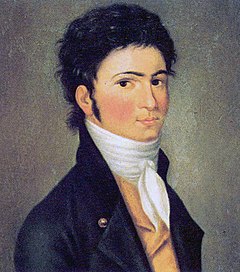Piano Concerto No. 2 (Beethoven)
| Piano Concerto in B-flat major | |
|---|---|
| No. 2 | |
| by Ludwig van Beethoven | |

The composer, who made in 1795 his public debut in Vienna playing the concerto at the Burgtheater, portrayed in 1801
|
|
| Catalogue | Op. 19 |
| Style | Classical period |
| Performed | 29 March 1795: Vienna |
| Published | 1801 |
| Movements |
|
| Scoring |
|
The Piano Concerto No. 2 in B-flat major, Op. 19, by Ludwig van Beethoven was composed primarily between 1787 and 1789, although it did not attain the form it was published as until 1795. Beethoven did write another finale for it in 1798 for performance in Prague, but that is not the finale that it was published with. It was used by the composer as a vehicle for his own performances as a young virtuoso, initially intended with the Bonn Hofkapelle. It was published in 1801 following Beethoven's Piano Concerto No. 1 in C major, which actually had been composed well after this piece in 1796 and 1797.
The B-flat major Piano Concerto became an important display piece for the young Beethoven as he sought to establish himself after moving from Bonn to Vienna. He was the soloist at its premiere on 29 March 1795, at Vienna's Burgtheater in a concert marking his public debut. Prior to that, he had performed only in the private salons of the Viennese nobility. While the work as a whole is very much in the concerto style of Mozart, there is a sense of drama and contrast that would be present in many of Beethoven's later works. Beethoven himself apparently did not rate this work particularly highly, remarking to the publisher Franz Anton Hoffmeister that, along with the Piano Concerto No. 1, it was "not one of my best." The version that he premiered in 1795 is the version that is performed and recorded today.
The work is scored for solo piano, flute, two oboes, two bassoons, two horns and strings. The concerto is in three movements:
The first movement begins with a triumphant orchestral opening on the tonic chord, and maintains a playfulness while using chromatic passages to show off the soloist's technique. The second movement is characteristically serene and peaceful, while the closing Rondo brings back the youth-filled playfulness heard in the opening movement.
...
Wikipedia
